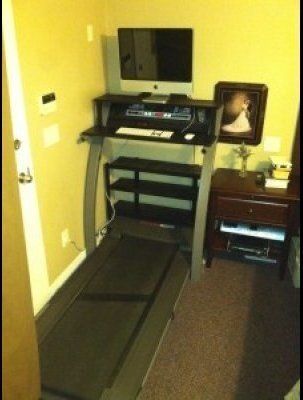
Studies showing that sedentary lifestyles are killing us have launched a thousand headlines. By now you’ve probably heard the catchphrase that “sitting is the new smoking,” in terms of danger to our health. The notion has even invaded pop culture. On sitcoms, the forceful corporate female character has swapped her power suit’s shoulder pads for a treadmill desk.
Switching things up from sitting to standing keeps the blood flowing and, according to studies, can help prevent illnesses such as Type 2 diabetes and cardiovascular disease. Here’s how to incorporate some standing room in your office space at home.
1. Think like an architect. As anyone who’s attended architecture school knows, drafting tables give you great options for standing and sitting. While most occupations don’t require a Mayline, electric eraser and tilting desk, the option of sliding over on a drafting stool or standing up helps you switch things around while you work. Frankly, I’ve never found a drafting stool that was at all comfortable, so they always inspired me to stand after about 20 minutes of sitting.
2. Place the standing desk outside the home office space. If you can do the bulk of your work on a laptop, there’s no need to clutter up your stand-up station. You can easily integrate it into a room outside of your office — and it’s nice to shake up your environment during the day and get in those extra steps while you’re moving between spaces. Also, you may be able to take advantage of a view you don’t get from your office, motivating you to get up, move around and stand more.
3. Think like a tiny-house owner. A simple flip-down surface tucks right up against the wall when not in use.
4. If you’re short on space but not into a flip desk, mount a desk to the wall. This makes adding a second desk possible in a small space. I recommend using adjustable brackets so you can get the height of the desk just right.
Speaking of which, it can be tricky to fine-tune a standing desk’s height. There are online calculators to help you figure out what’s best ergonomically based on your body measurements. Be sure to wear shoes that give good support when standing and factor those into your height measurement. You may also decide to add a supportive mat, like the ones commonly used in kitchens in front of the sink. If you do, you’ll need to factor this into your height measurement as well. If more than one member of the household will be using the desk, you’ll want one that is height-adjustable.
5. Incorporate a bilevel solution. I don’t know many people who want to stand all the time; having a place to sit when the mood strikes is a good solution. This high credenza shelf doubles as a standing work surface, but a more traditional built-in desk allows for seated work.
This home office arranges the traditional desk and the standing desk in an L-shaped configuration.
6. Create a perch with a view. A desk that cantilevers off a railing, for example, providing a view down to the main living space and out windows can draw the family over for some stand-up work.
7. Go for a mad-professor look. The mix of wood and iron on the tall French table, the anatomical chart, the lamp and the other accessories all give this home workspace vintage academia-style appeal. No doubt the discomfort of sitting on that stool boosts the user right out of his or her seat and into a standing position.
8. Incorporate standing for craft time too. Big, messy projects often require spreading out and standing up. Clever stations have sitting and standing options, like tall stools. Placing the island in the middle of the room, for example, leaves space all around for working and spreading out.
More from Houzz.com:
Also on HuffPost
